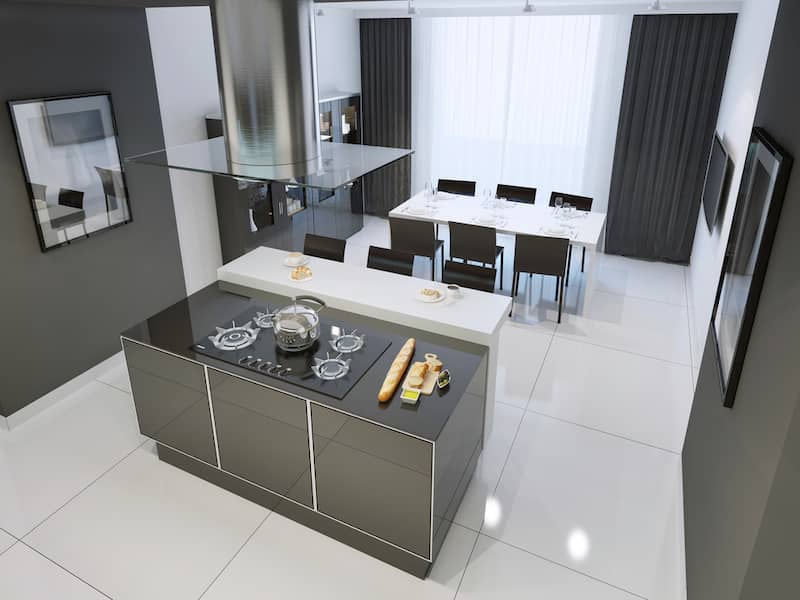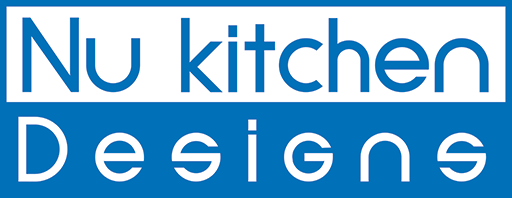Embarking on a kitchen renovation journey involves making thoughtful decisions, particularly when it comes to choosing the best flooring for kitchen. As a homeowner, I understand that the kitchen flooring isn’t just a foundation—it sets the tone for the look and feel of the entire kitchen space.
When considering the best kitchen flooring materials, a multitude of options unfold before you, each bringing its unique blend of aesthetics and practicality. Whether it’s the timeless elegance of hardwood flooring, the water-resistant qualities of vinyl flooring, the natural beauty of stone tiles, or the popular ceramic tile, your choice needs to align with your personal style while standing up to wear and tear that comes with heavy appliances and direct sunlight.
From ceramic or porcelain tile options to innovative engineered wood flooring, this guide will delve deep into the top 11 flooring materials, helping you navigate through an array of choices like bamboo flooring, cork flooring, and more. Our aim? To assist you in finding a durable kitchen flooring option that not only meets your expectations but elevates your kitchen to a whole new level.
Join me as we explore the world of flooring solutions, ensuring your new kitchen floor is not only a sight to behold but also a wise investment for years to come.
Table of Contents
ToggleWhy Kitchen Flooring Matters
Impact on Home Value
Choosing the best flooring for your kitchen is not just about aesthetic appeal; it significantly impacts the home value. Prospective buyers often prioritize modern and resilient kitchen surface options, indicating a well-maintained home. A wise selection from popular kitchen floor materials like hardwood flooring or natural stone tile can enhance the value substantially.
Functional Implications: Durability and Longevity
Aesthetic Considerations
Factors to Consider When Choosing Kitchen Flooring Material
Lifestyle and Usage Patterns
Understanding the specific demands of your lifestyle and usage patterns is a foundational step in selecting the right kitchen surface materials. Consider the dynamics of your household – whether you have young children or pets- which could require flooring that can handle high traffic and potential spills.
For instance, tile flooring and vinyl plank are known for their resistance to wear, making them suitable choices for busy households. Moreover, if you frequently entertain or have larger appliances, opting for a hard-wearing kitchen surface choice like stone tile, which can endure the weight and frequent use, would be prudent.
Budget Considerations
When remodeling your kitchen, it’s crucial not to overlook the flooring, as it is a pivotal element that ties the entire renovation together. According to Forbes Home, on average, flooring can constitute about 7% of the total project cost, approximating around $4,200, although this figure can fluctuate depending on your specific choices and the area of your kitchen area.
To break it down further, here’s a snapshot of average costs and some of the more budget-friendly flooring materials:
– Tile: $6 – $20 per square foot
– Vinyl: $3 – $7 per square foot
– Laminate: $3 – $10 per square foot
– Linoleum: $3 – $7 per square foot
– Cork: $5 – $12 per square foot
– Bamboo: $5 – $12 per square foot
– Concrete: $2 – $8 per square foot
The overall cost can range from $850 to $1,900, providing options to choose a flooring material in accordance with your budget but without sacrificing quality. Keep these figures in mind as you navigate through various kitchen flooring ideas, ensuring a balance between aesthetics and expenditure.
Climate and Environmental Factors
Climate and environmental aspects play a vital role in the longevity and maintenance of kitchen floors. Different flooring solutions respond distinctively to various climatic conditions.
In regions prone to high humidity, it’s wise to consider flooring options like porcelain tiles or engineered wood, which offer better resistance to moisture compared to solid hardwood floors.
For homes situated in areas receiving substantial sunlight exposure, consider materials like concrete flooring or natural stone tiles, which won’t fade easily and can handle temperature fluctuations with grace.
Furthermore, opting for eco-friendly materials such as bamboo flooring or cork (ground-up cork combined with other materials) provides not only a durable solution but also an eco-friendly choice, adding a green touch to your home renovation project.
Installation and Maintenance
The installation and maintenance of your chosen flooring material are critical aspects to ponder. Certain materials like solid wood or stone tiles might require professional installation to ensure perfection and longevity. These materials, though offering a luxurious finish, often necessitate a higher degree of maintenance to prevent stains and preserve their aesthetic appeal.
On the other hand, options like laminate floors or vinyl tile offer the advantage of easy installation, potentially lowering the overall cost.
Additionally, considering features like water-resistant or completely waterproof capacities, especially in kitchen spaces prone to spills, can prove beneficial in the long run.
Always aim for a balance between durability and maintenance to enjoy a beautiful yet functional culinary space for years to come.
Top 11 Durable & Easy-to-Maintain Kitchen Floor Choices
In our quest to find the best solutions for modern homes, today we delve into the realm of kitchen flooring choices that are not only visually appealing but are also robust enough to sustain the demands of daily life.
Here’s a comprehensive list of the most durable kitchen flooring options that homeowners like yourself might consider:
1. Hardwood Flooring

Best for: Endurance to wear and tear, enhancing home value, versatile style options
Pros:
Longevity: When maintained properly, hardwood floors can last for decades, offering excellent value for money.
Visual Appeal: Offers a timeless, classic aesthetic that can complement various design schemes.
Adds Home Value: Hardwood flooring is a sought-after feature for many homebuyers, potentially increasing the value of your home.
Cons:
Not Completely Waterproof: Despite being treated for water resistance, it isn’t entirely immune to water damage, making it less suitable for areas prone to spills or flooding.
Cost: Installing hardwood flooring can be a considerable investment, especially when opting for solid wood options.
Maintenance: Requires a regular maintenance routine to retain its beauty and functionality over time.
2. Laminate Floor
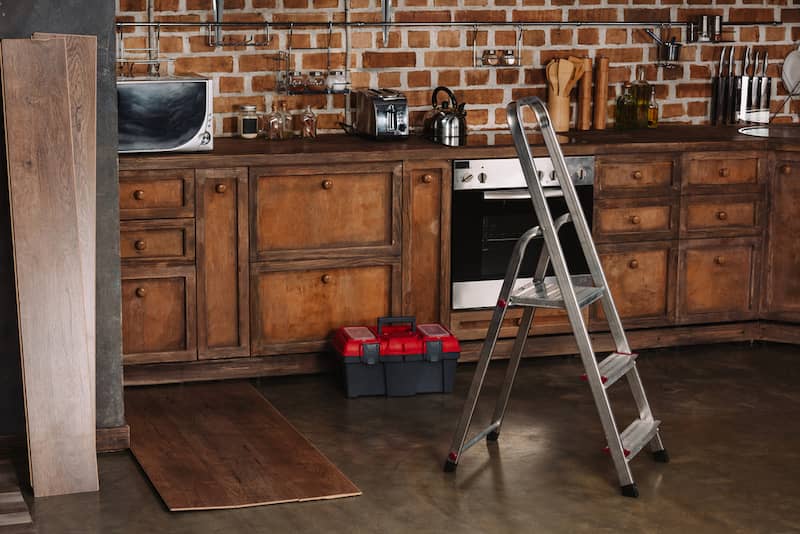
Best for: Cost-efficiency, easy installation, and versatility in design
Pros:
Cost-Effective: Laminate flooring offers the look of wood or stone flooring but at a fraction of the cost.
Easy Installation: With options like click-and-lock designs, installing laminate flooring can be a simpler and quicker process compared to other flooring types.
Variety in Designs: A laminate floor comes in a wide array of designs, effectively mimicking other popular flooring materials, giving homeowners vast choices for their kitchen flooring ideas.
Stain Resistant: Most laminate flooring solutions come with a protective layer that makes them resistant to stains, which is particularly beneficial in a kitchen setting.
Cons:
Not Completely Waterproof: While laminate flooring has come a long way with options now, including varieties like waterproof laminate, it’s worth noting that not all types are fully waterproof. This makes some laminate choices susceptible to damage in the event of water spillage or flooding.
When choosing laminate, consider the waterproof variants to add an extra layer of protection against potential water damage.
Cannot be Refinished: Unlike hardwood floors, laminate flooring cannot be refinished. Once it wears down, replacement is the only option.
Potential for Lower Home Resale Value: Laminate floors might not add as much value to your home compared to natural or engineered wood flooring.
3. Ceramic and Porcelain Tiles
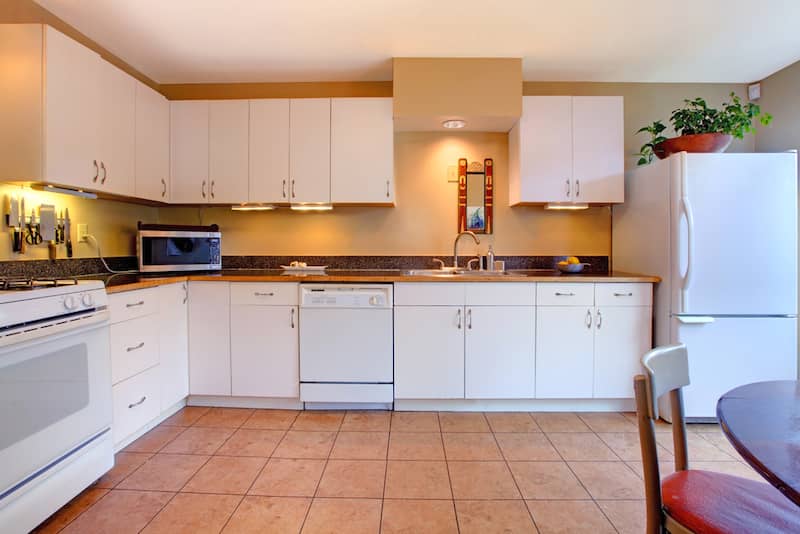
Best for: High-traffic areas, water-resistant properties, variety in aesthetic choices
Pros:
Durability: Both porcelain and ceramic tiles are known for their resistance to damage, offering a highly tough kitchen surface option, even in high-traffic areas.
Water Resistance: These kitchen floor tiles offer water-resistant properties, making them an excellent choice for areas prone to spills. Porcelain tile, in particular, is renowned for being water-resistant, adding a layer of protection to your kitchen floors.
Variety of Styles: Tile flooring, whether porcelain tile or ceramic tile, comes in a plethora of styles, patterns, and colors, allowing homeowners to customize their spaces to their tastes.
Cons:
Installation: The process of installing kitchen flooring of this kind can be labor-intensive. A professional flooring installation team often best manages it to ensure precision and longevity.
Comfort: Porcelain tile and ceramic tile flooring materials can be hard underfoot, potentially causing discomfort during prolonged standing periods.
Maintenance: Though fairly easy to clean, the grout lines can accumulate dirt and stains over time, necessitating periodic deep cleaning to maintain its appeal.
4. Vinyl Flooring
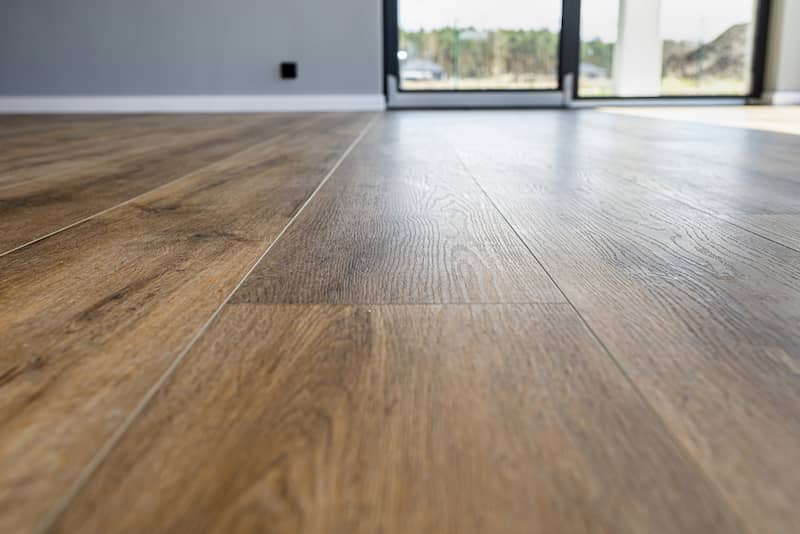
Best for: Budget-friendly renovation, adapting to various style preferences, offering water-resistant properties
Pros:
Affordability: Vinyl flooring, including options like vinyl plank and vinyl tile, comes at a fraction of the cost compared to many other kitchen surface solutions, making it a popular option for budget-conscious homeowners.
Water Resistance: One of the standout features of vinyl is its water-resistant property. It stands up well to spills and is nearly water-repellent, especially in sheet vinyl variants, making it a stellar choice for kitchens.
Easy Installation: Vinyl products often come with easy-to-follow installation guidelines, making it a potentially good choice for DIY enthusiasts. However, for a flawless finish, considering expert flooring installation is advised.
Variety of Styles: Whether you’re a fan of contemporary or classic styles, vinyl flooring offers an extensive range of patterns and colors that can mimic organic materials or offer bold, unique designs.
Cons:
Durability: While vinyl is resistant to water and wear, it might not withstand large appliances and extreme conditions over a long period, especially when compared to more sturdy kitchen floor options like stone tile or hardwood.
Potential for Damage: Vinyl floors can be susceptible to tears and scratches, especially in areas with high foot traffic or under heavy furniture.
Resale Value: Compared to solid hardwood floors or natural stone tile, vinyl flooring might not add as much value to your home in terms of resale value.
5. Concrete Flooring

Best for: Industrial and modern home styles, resisting wear and tear, compatibility with underfloor heating systems.
Pros:
Durability: Concrete flooring is known for its resilience and ability to withstand hefty appliances and daily deterioration, making it one of the toughest kitchen floor alternatives available.
Customization: A concrete floor can be polished, stained, or stamped to create a variety of styles, from sleek and modern to rustic and traditional. This makes it a versatile choice, offering a plethora of kitchen flooring ideas.
Ease of Maintenance: Concrete is straightforward to maintain. Regular sweeping and mopping are generally all that’s needed to keep it looking its best. Moreover, it’s stain-resistant, which means it can handle spills without sustaining damage.
Cons:
Hard Surface: Concrete is an extremely hard material. While this means it’s resistant to damage, it also means it can be uncomfortable to stand on for extended periods.
This can be mitigated somewhat by using rugs in areas where you stand most frequently, like in front of the sink.
Cold: Concrete does not retain heat well, making it cold underfoot, particularly in the winter months. This can be mitigated by installing underfloor heating systems.
Cost: While concrete itself is not overly expensive, the cost of installation can be considerable, especially if you opt for finishes like staining or polishing.
6. Marble
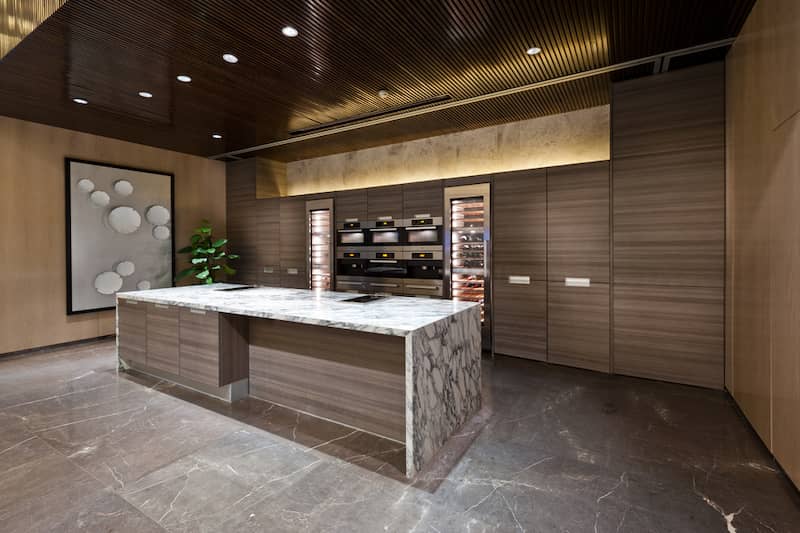
Best for: Upscale homes seeking a touch of luxury and sophistication, enhancing the kitchen’s visual appeal, and increasing property value.
Pros:
Luxurious Appeal: Marble is synonymous with luxury and elegance, and having marble kitchen flooring can significantly enhance the aesthetic value of your home.
Unique Patterns: Each marble tile is unique, offering a wide variety of patterns and hues, which means your kitchen floor will be one-of-a-kind.
Increases Home Value: Similar to hardwood flooring, marble is often a desirable feature that can potentially increase the value of your home, making it a worthy investment for homeowners looking for upscale kitchen floor materials.
Cons:
Cost: Marble is a premium material, and installing it as your kitchen flooring can be quite an investment. The cost per square foot can be significantly higher compared to other flooring options.
Maintenance: Marble is prone to staining and requires regular maintenance to prevent damage from spills and oversized appliances. Moreover, it needs to be sealed periodically to maintain its luster and prevent damage.
Susceptible to Scratches: Unlike some other stone tile options, marble can be relatively soft, making it susceptible to scratches from sunlight or damage over time.
7. Natural Stone
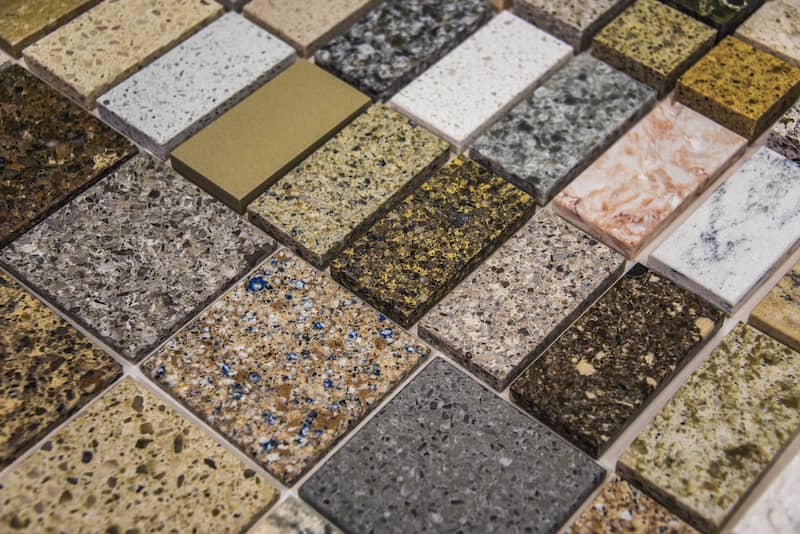
Best for: Elevating a home’s aesthetic with a touch of nature, serving as the longest-wearing natural stone flooring option, and offering an extremely durable choice for areas with high foot traffic.
Pros:
Durable & Long-lasting: Natural stone floors are known to be extremely durable and can withstand the test of time. Among all the flooring options, they stand as some of the longest-wearing natural stone solutions available.
Unique Aesthetics: Each stone tile offers a unique pattern, color, and texture, ensuring that no two stone floors are exactly the same, adding a bespoke feel to every home.
Adds Home Value: Much like hardwood, a stone floor is a sought-after feature for many homebuyers, potentially enhancing the value of your home.
Cons:
Maintenance: Natural stone might require sealing and periodic maintenance to retain its luster and prevent staining.
Cost: Natural stone is often on the pricier side, making it a significant investment compared to other flooring options.
Hardness: A stone flooring can be hard underfoot, potentially making them less comfortable than some of the other options listed.
8. Brick
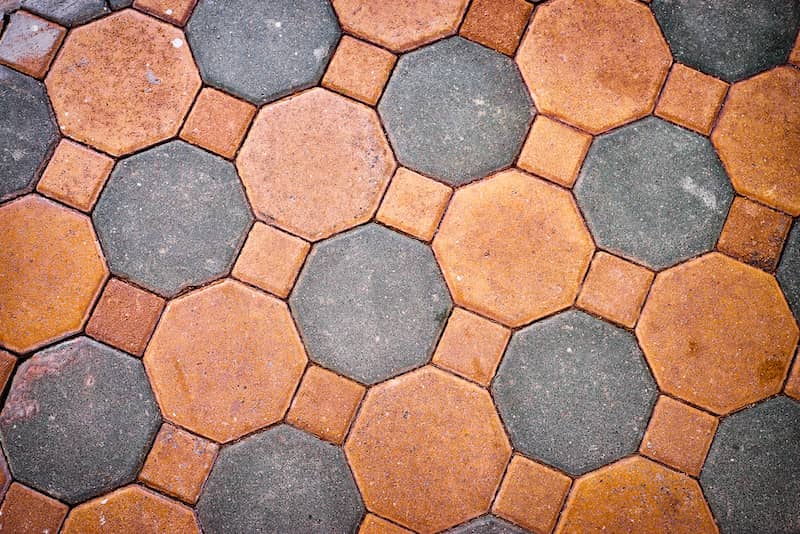
Best for: Historic aesthetic appeal, excellent durability, and a unique touch to your kitchen area.
Pros:
Distinctive Appearance: Brick flooring brings a rustic and historical charm that can make your kitchen stand out.
Durability: Known for its strength, brick can withstand a considerable amount of deterioration, making it a long-lasting option.
Natural Material: Being a natural material, it lends an earthy vibe, blending seamlessly with various styles, including country, rustic, and traditional designs.
Cons:
Maintenance: Brick flooring can be a bit challenging to maintain as it may require sealing to prevent moisture absorption and staining.
Hard Surface: This type of flooring can be hard underfoot, which might be uncomfortable during long periods of standing.
Installation: Installing brick flooring can be a meticulous process, usually requiring professional flooring installation to ensure longevity and aesthetic appeal.
9. Bamboo

Best for: Eco-friendliness, modern aesthetics, and quick renewable resource
Pros:
Sustainability: Made from a fast-growing resource, bamboo flooring, including options like solid bamboo and engineered bamboo, represents an eco-friendly choice.
Pulped bamboo is utilized to create a flooring material that renews much faster than traditional hardwoods.
Modern Aesthetics: Bamboo flooring offers a clean and modern look that can bring a fresh, contemporary style to your kitchen. Its unique grain patterns can be a stunning visual focus in your home.
Durability: Bamboo, especially when opted in its solid form, provides considerable resistance to damage, making it a long-lasting option for homeowners who prefer sustainable materials.
Cons:
Susceptibility to Moisture: Like hardwood, bamboo can be prone to damage from excessive moisture. It’s not non-porous, which might be a concern in kitchens where spills are commonplace.
Potential Quality Variations: Depending on the manufacturing process, the quality of bamboo flooring can vary significantly. It’s crucial to choose high-quality options to ensure durability.
Cost: High-quality bamboo flooring, particularly engineered options, can be a significant investment initially, albeit a worthwhile one considering its longevity and aesthetic appeal.
10. Cork
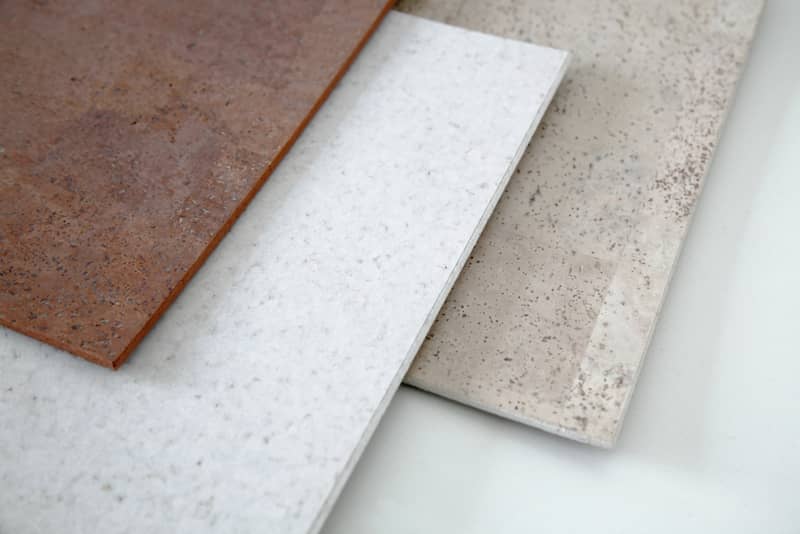
Best for: Eco-friendly enthusiasts, comfortable & soft underfoot surface, adapting to temperature variations
Pros:
Sustainability: Cork flooring is manufactured from the bark of cork oak trees, which naturally regrow, making it a renewable resource. It’s a great choice for homeowners looking for sustainable materials.
Comfort: Notably soft underfoot, cork provides a comfortable walking and standing surface, which can be a relief in areas like the kitchen where you may spend a lot of time on your feet.
Insulating Properties: Cork naturally insulates against both temperature and noise, offering a quieter and warmer kitchen environment.
Cons:
Susceptible to Damage: Despite its many benefits, cork flooring can be damaged by robust appliances and sharp objects, and it may show wear over time.
Maintenance: Cork floors require sealing to be water-resistant and might need frequent resealing to maintain their properties.
Color Alterations: Direct sunlight can cause cork flooring to fade over time, so it’s advisable to use window treatments to minimize exposure.
11. Linoleum
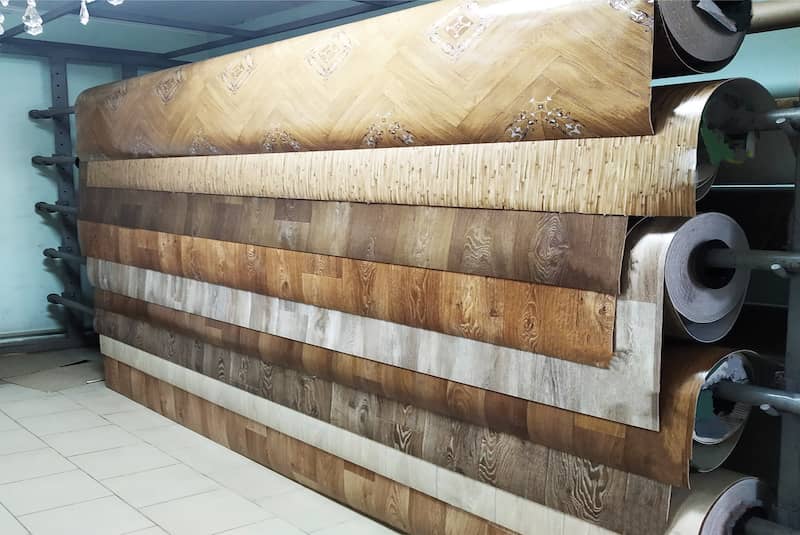
Best for: Eco-friendliness, budget-friendly, varied design options
Pros:
Eco-Friendly: Made from natural materials like linseed oil and cork dust, linoleum is a sustainable choice for the environmentally conscious homeowner.
Affordable: Compared to other flooring options, linoleum offers a budget-friendly yet dependable kitchen floor solution, providing good value for money.
Design Flexibility: Available in a wide array of colors and patterns, linoleum allows you to tailor your kitchen floor to suit your personal style and home décor.
Cons:
Susceptible to Tears and Scratches: While linoleum is a durable option, it can be vulnerable to tears and scratches from large appliances or sharp objects.
Maintenance: Requires periodic maintenance, including sealing, to maintain its appearance and prevent moisture absorption.
Discoloration: Continuous exposure to direct sunlight can cause discoloration over time, requiring homeowners to take preventive measures such as using curtains or shades to protect the flooring
Talk to Professional Flooring Contractors for Guidance
Choosing the right, durable, and best flooring material for your kitchen isn’t just about aesthetics; it’s an investment in your home’s future. I can’t stress enough the significance of making an informed choice. Each option has its unique merits, and what works for one household might not be suitable for another.
As you weigh your options, considering your home’s needs and style, don’t hesitate to seek expert advice. The team at NU Kitchen Designs is always ready to assist you in ensuring you choose and install kitchen flooring and make kitchen remodeling that’s the best fit for your home.

